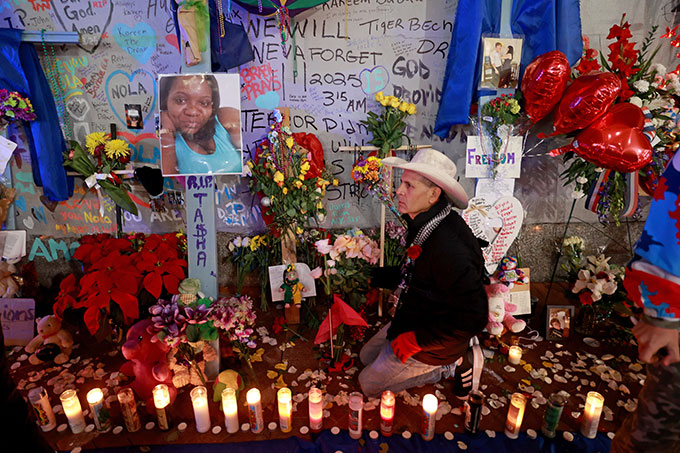Twenty years ago today, Hurricane Katrina blew through the Gulf Coast, killing about 1,000 people in Louisiana and 200 in Mississippi. The indelible images from the storm show thousands of people in New Orleans trapped on rooftops and highway overpasses, and the unalterable narrative became one of racism and anti-urbanism: as singer Kanye West infamously alleged about the then-president in a televised fundraiser days later, “George Bush doesn’t care about black people.”
But Katrina wasn’t an emblem of centuries of concentrated discrimination. It was something more suggestive of the nation’s future rather than its past: a preview of an era of diffused incompetence.
The simple image persists: bedraggled people, mostly black, standing waving on rooftops, sitting or lying on concrete, waiting for a government that won’t come. But the image is superficial and misleading. Most New Orleanians—black, white, and other—don’t appear in those images because they had evacuated themselves. About 80 percent of the city left ahead of the storm. The people on the rooftops looked disheveled not because America had previously kept them in a racist cauldron of neglect but because they had, in many cases, escaped the storm by breaking through their own roofs, and then spent hours or whole nights outdoors. You would look unkempt and uncared-for, too.

Why they remained, and then waited so long for rescue, is also more complicated than alleged Bush administration indifference. Louisiana’s governor, Kathleen Blanco, and mayor, Ray Nagin, were both Democrats and had every motive to work together, but they were slow to help the elderly and other vulnerable people reach safety beforehand, and they failed to position sufficient resources, like National Guard troops, nearby ahead of the storm for quick rescue afterward. Ironically, given the perspective from two decades later, with the Trump administration having seized control of policing in Washington, D.C., Bush incurred criticism in part because he didn’t want to exert federal power to take over troop and overall response command from the state.
It was local officials, not national ones, who initially spread the tales of crime and looting hampering rescues. As the New Orleans Times-Picayune concluded a month later, “some of the most lurid rumors of violence in the Superdome and the New Orleans Convention Center came from those in charge: Mayor Ray Nagin and Police Superintendent Eddie Compass. And now it appears they were mostly false.” Though the Convention Center, an evacuation site, did suffer one murder, Katrina was a harbinger of our post-truth era: it is still not clear what happened.
The lesson from Katrina about New Orleans was that massive disasters reveal underlying realities. New Orleans had been losing population for decades, and it lost more afterward; with about 363,000 residents today, the city is 21 percent smaller than it was before the storm and barely half of its peak 625,000 population a decade after World War II. New Orleans was a high-crime city pre-Katrina, and it remains one.
New Orleans’s economy had struggled before Katrina, losing jobs steadily in the decade before the hurricane. Once the tens of billions of dollars in rebuilding aid ran out—aid that juiced jobs in construction and services—the city reverted to its previous trend, albeit at an accelerated rate: New Orleans, including a nearby suburb, has about 7 percent fewer private-sector jobs than it did in 2004, the year before Katrina. The city was dependent on tourists back then and is even more so now, but it has 9 percent fewer leisure and hospitality jobs today than it did in 2004.
New Orleans suffered a terror attack last New Year’s Day, with 14 people on Bourbon Street killed by a murderous truck driver. Responsibility for the attack lies solely with the ISIS-aligned killer, of course, but the city’s failure to protect Bourbon Street revelers with functional anti-vehicle bollards is typical of its general negligence.

Lost in all the focus on race in the immediate aftermath of Katrina was a more mundane failure that made its impact far worse: that of the region’s flood-protection system, built by the federal government’s Army Corps of Engineers. Congress and the president subsequently spent billions building new flood-protection infrastructure.
From a national perspective, however, the longer-term lesson from Katrina is starker. The Bush administration acted to take responsibility to rebuild, going far beyond infrastructure reconstruction because failure then seemed aberrant, unacceptable, and fixable. Bush himself forthrightly accepted criticism. “Katrina exposed serious problems in our response capability at all levels of government,” he said. “To the extent the federal government didn’t fully do its job right, I take responsibility.”
Try to imagine a public official saying that today, when ineptitude seems like the default. From the financial crisis of 2008 to the lockdown-induced social disintegration of 2020, things fall apart, and people notice—but nobody in charge wants to take long-term responsibility for fixing them. The vacuum of leadership propelled the rise of Donald Trump.
The most fitting coda to Katrina isn’t its anniversary this week but an event from earlier this summer, in July, when floods in Texas’s hill country killed at least 134 people. Among the dead were two teenage counselors and 26 campers, all young girls, at Camp Mystic in Kerr County. These deaths were preventable, but they were not prevented. The camp’s owners knowingly allowed defenseless children to sleep in a floodplain, and state regulators did not require the camp to formulate a realistic, rehearsed evacuation plan.
The waters rose so fast that the girls never had the chance to try to punch through the deadliest cabin’s roof. But unlike George W. Bush 20 years ago, Texas governor Greg Abbott said that assigning blame was “for losers.” And the world has moved on.
Top Photo by JIM WATSON/AFP via Getty Images
City Journal is a publication of the Manhattan Institute for Policy Research (MI), a leading free-market think tank. Are you interested in supporting the magazine? As a 501(c)(3) nonprofit, donations in support of MI and City Journal are fully tax-deductible as provided by law (EIN #13-2912529).

















